Shadow of the Cabal is a L5R Actual Play Podcast, available on iTunes and Google Play.
Don't wanna be here? Send us removal request.
Photo

I’ve been working on this commission for @sotcpod for a while now and finally finished it tonight! Now go follow them and listen to their podcast
33 notes
·
View notes
Text
Acadecon 2017 Giveaway!
Shadow of the Cabal is running a contest to give away a handful of badges to Acadecon, the RPG Academy’s tabletop gaming convention in Dayton, OH, running November 10-12. The whole crew of the show is going to be there, running and playing tabletop games for the weekend, and we would love to see you there.
As an RPG Academy Network member, we have a few badges to give out to listeners, and it’s super simple to enter.
To enter, send us your fan creations for Shadow of the Cabal. The entries can be art, writing, music, videos, or anything else that is inspired by our show. Fan creation can be anything: art, haiku, videos, music or anything that involves or is inspired by the podcast. Something to do with your favorite moment in the podcast or character is a great start. We won’t share the work with the public unless you give us permission to, so feel free to go wild with something that inspires you.
To send us your entries, you can tweet or DM them to me on Twitter at @sotcpod , or email the entry to [email protected].
The deadline for the contest is September 1st, so make sure to get your entries in before then!
Please note that travel and hotel fees are not included in the giveaway.
We hope to see you there!
0 notes
Text
Announcements for SOTC
For those who don’t follow the show on Twitter (which I recommend you check out!), we have a couple of big exciting announcements for Shadow of the Cabal!

Firstly, we have joined the RPG Academy Podcast Network! They are an awesome group of like-minded RPG gamers and podcasters who have been doing this for years and years. Their series of L5R Actual Play podcasts were a big factor in motivating us to start our own series, and we are happy to be among our new friends, and living the RPG Academy mantra of “if you’re having fun, you’re doing it right.” I spoke briefly to Michael (the head of the network) about SOTC and my background in gaming, if you want to listen to that episode, check it out here. You can expect to possibly hear our voices on more extracurricular podcasts on the RPG Academy feed, I recommend you check them out and look at some of the other incredible shows on our network.
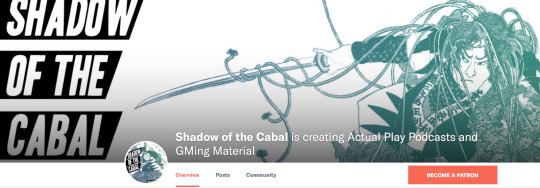
Secondly, we have launched our Patreon! Here, you can check out some of the extra goodies that we are offering to patrons to help keep the show running. Shadow of the Cabal will always be free, but we want to keep growing and Patreon is the best way to help us do that. Thank you so much to those who have contributed already (!). Financially supporting the show sends a clear message to all of us: “Shadow of the Cabal matters to me.” If that sounds like something you feel, please check out the Patreon and consider backing. We love you all.
Here’s to twelve more centuries of samurai goodness.
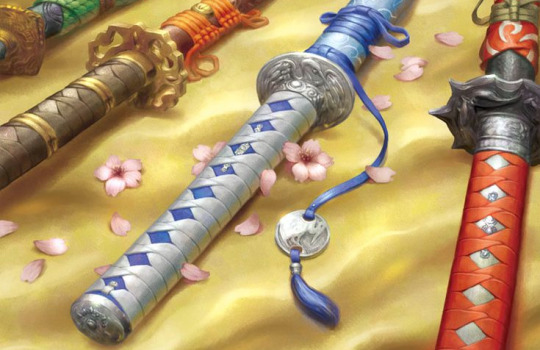
1 note
·
View note
Text
Director’s Commentary: Episode 2
This will be a whenever-I-feel-like-it series of blog posts where I go back and re-listen to episodes of my show, Shadow of the Cabal, and talk about some of the decisions and things that I made at certain points, and hopefully we can all learn from it. Enjoy!
Needless to say, these posts WILL contain spoilers for the episodes, so listen to them first!

00:54 - I like that early on we get this other facet of shugenja life through Isawa. Not only are shugenja serving their lords via their gifts with the kami, but they also serve as priests and officials for religious functionaries (such as cleansing a corpse). Not a side of shugenja we see very often on the show (mainly because it’s not very exciting most of the time).
01:59 - Ryan was way onto the eta as the killer from quite early on. I love this scene of him grilling Doru.
02:35 - Being a samurai always means being within a few feet of death, but I really attempt to portray death and violence as brutal, nasty, and undignified to drive home that honor in death isn’t all it’s cracked up to be.
03:38 - If Isawa made that Perception roll, he would have noticed Doru wiping the telltale foam from Shotetsu’s mouth after he died of his poisoning.
05:07 - If you’re gonna run mystery games, have core clues. AKA clues that need no roll to obtain. These are clues that you need to move the story forward. Call for a roll to get more info out of the clue, but if it’s an observation that needs to be made to keep the narrative moving forward, give it to them without a roll and move on. In this case, the core clue was here to get Isawa onto the fact that some foul play was involved, probably poison.
06:19 - Doru, as someone who doesn’t really support the idea of the Celestial Wheel, gives a very noncommittal answer.
07:40 - Ryan built his character with a lot of ammo for me to screw him over with. Don’t be afraid to make vulnerable characters in RPGs, it will only make the story better.
09:30 - This scene (the interrogation of Fujiyo) contains another core clue (her account of being absent during Shotetsu’s death). In retrospect, I shouldn’t have had Dakota roll Interrogation for this scene to happen.
10:05 - Asahina Sango’s treachery begins!
11:18 - As the group was eating (and Shotetsu was poisoned), Doru nicked one of Fujiyo’s arrows to frame her with. Samurai don’t pay any attention to eta, especially when they are eating, so there really wasn’t a chance he could have been spotted in the commotion surrounding lunch time.
12:46 - Kitsuki inadvertently shuts down Fujiyo from implicating Asahina in the whole affair. Oops!
13:07 - I kind of love that the players never got an answer as to what Fujiyo’s blackmail material was. Sometimes you just never get the whole story! As a GM, don’t be afraid to not give your players the answers or explanations to every single mystery that comes up during play. Keeping a few things here and there a mystery makes the world feel bigger and more real, as all of these NPCs are supposedly their own people with lives and interests and secrets that are none of the player’s concern.
13:50 - Fujiyo got her eyes on an Oni’s Tear.
15:08 - Ryan decides to have Isawa chat with the kami of the area. He could have done this in a variety of places. Asking the kami at the crime scene would have also been a stellar idea, and I think that was Ryan’s first idea before he witnessed the scene at the river.
15:12 - I was surprised that Kitsuki wasn’t more concerned at finding the culprit alone, and Isawa nowhere to be seen.
15:44 - This was an awkward way to try to get Dakota to question the wound on Shotetsu. Because Shotetsu was already dead when he was shot with the arrow, he didn’t bleed out as much as he might have. I should have given that clue a bit more clearly.
17:15 - Ryan instinctively does what I consider to be a good play habit. When making a roll for a task, it’s often better to roll first and then describe it or RP it based on the roll you got, rather than go all-out RPing something and then rolling crap on it and being disappointed.
18:28 - I know that Water kami aren’t supposed to communicate verbally, but I wanted to do a cool voice and the opportunity was too good to pass up.
22:25 - Isawa’s matter-of-fact statement and the silence that followed is maybe one of my favorite moments of this first session.
23:09 - Dakota helping with the good world exposition (Rokugan’s criminal justice system sucks).
23:44 - Ryan blows the case right open. I was pretty proud to see them get to the truth.
24:52 - I don’t like this call that I made. One of the GM principles I am a fan of is “don’t call for more than one roll for something if one roll could suffice”. I should have just assumed that Isawa could have described what he saw fine, and it was up to Kitsuki to ID it.
27:19 - Bayushi hadn’t got much action in these episodes yet, so I decided to shift over to give her some spotlight time with Shinjo. I totally forgot to use my Shinjo voice, though. :( 30:04 - A good guess from Justin, but he didn’t take into account that this was a Kolat game!!! Stupid Justin!
34:33 - Sometimes it’s good to put a solid deadline on adventures. By me informing the group that they had around an hour to wrap things up, I am thereby informing them that “you have found all the relevant clues in this area, if you wanna ask questions before everyone disperses now is the time”. Deadlines put pressure on the story to reach a conclusion one way or another and prevent mysteries from spinning in circles if they go wrong.
38:28 - Oops I lied here.
46:18 - I sensed that the party was sort of less than satisfied at the conclusion they arrived at. They were correct in assuming that there was more going on than they could tell or get their hands on, but sometimes L5R is a tragedy and it ends on a sour note. In this case, they knew the eta had to take the fall for the crime, and they had to trust me as the GM to resolve the details of the bigger picture later. This is Shinjo acting as my mouthpiece here.
That will do it for this episode’s retrospective. As always, if you have any questions or comments about anything, hit us up on Twitter.
2 notes
·
View notes
Text
Character Bios
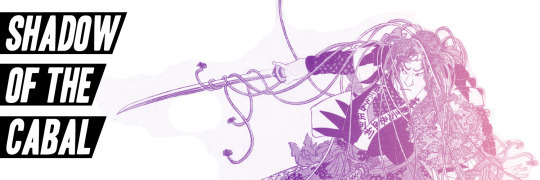
Meet your yoriki. All three samurai have recently come into the service of the esteemed Emerald Magistrate Shinjo Shinpachi, ready to serve the empire and their lord in ferreting out the conspiracies within Rokugan.
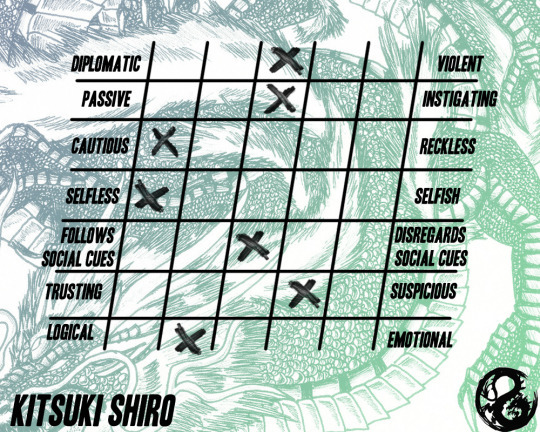
Kitsuki Shiro
Clan: Dragon
School: Kitsuki Investigator
Age: 19 Born as the son of an Emerald Magistrate and a monk, Kitsuki Shiro enjoyed a relatively rigorous life of youth, training his martial arts among the monks and his perception among courtiers of the Dragon Clan in equal measure. During his gempukku ceremony, Shiro received a large tattoo of a guardian dog across his back as a gift from his mother. When Shiro was 17, his father was found murdered, and he found his service transferred to his father’s old friend, Shinjo Shinpachi, to work for the Magistrates far away from the lands of the Dragon. Shiro is inquisitive, stoic, and cool under pressure, and serves Shinjo well.

Bayushi Akina
Clan: Scorpion
School: Bayushi Bushi
Age: 23 Akina was born into a middle-ranking Bayushi family with minor appointments to the castle of Kyuden Bayushi, the youngest of her four siblings. A rash, precocious child, she soon found her true calling in the dojo, training to master the arts of the warriors of the Scorpion Clan. Her boldness was matched only by her talent, and her sensei soon found Akina to be the top of her dojo in terms of combat skill. While her older siblings found themselves betrothed and married off to more prestigious appointments, Akina’s natural talent could not substitute her lack of social desirability. When a wandering Emerald Magistrate stopped to observe a festival tournament in the Bayushi lands, Akina caught the eye of a certain Shinjo Shinpachi as she defeated her opponent in a spectacular duel. Shinjo arranged for Akina to serve as one of his personal bodyguards, and the rest is history.
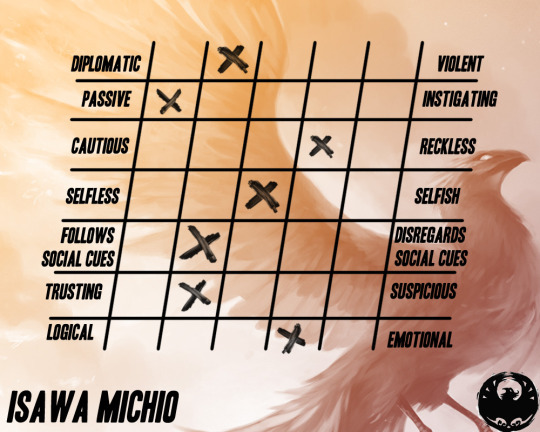
Isawa Michio
Clan: Phoenix
School: Komori Shugenja
Age: 21
Isawa Michio has always found himself to be an undesirable. Due to the questionable legitimacy of his birth and heritage as a samurai, ordinarily the Phoenix Clan would be happy to sweep him under the rug with some minor appointment and let him live out the rest of his days in obscurity. But the Fortunes had a different plan for Isawa, as he was born with the gift to see and speak with the Kami. The Isawa masters found themselves in a dilemma, but quickly solved it by shipping Michio off to the Isles of Silk and Spice, to train with the shugenja of the Bat Clan, a forgettable Minor Clan whose talents with the Kami allowed them the use of instantaneous long-distance communication. Michio kept his head down and spent his free time taking up cartography, his one and only passion. When Shinjo Shinpachi heard from a colleague in the Isles that there was a Bat-trained shugenja with a talent for making maps, Shinjo immediately arranged for Isawa to come into his service, as his talents would no doubt benefit the Emerald Magistrates immensely.
7 notes
·
View notes
Text
Director’s Commentary: Episode 1
So, this will be a whenever-I-feel-like-it series of blog posts where I go back and re-listen to episodes of my show, Shadow of the Cabal, and talk about some of the decisions and things that I made at certain points, and hopefully we can all learn from it! So, we are gonna start with Episode 1 of the show. Needless to say, these posts WILL contain spoilers for the episodes, so listen to them first! Listen along here!
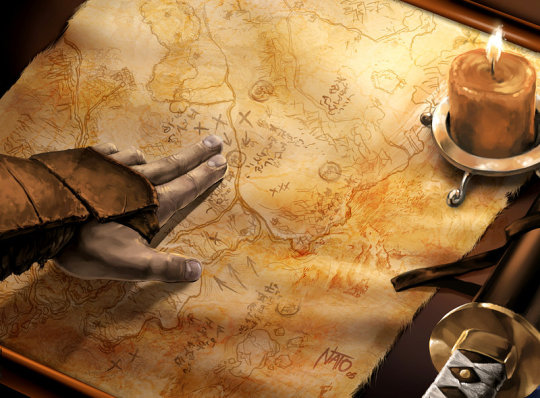
General Comments: Episodes 1 and 2 were both recorded and edited from the same session. This isn’t the first campaign I have played through with this group, so we were able to skip the “I don’t know any of these people” awkwardness and get straight to “I don’t know anything about our characters” awkwardness.
Woof, the audio quality on this one. It’s no secret that most podcasts sound better as they go on, and my editing and work flow has definitely changed to allow a higher standard of edits and audio quality. One thing that bothers me about this episode is how fast some of my edits are, I was way too afraid of having even a second of dead air, so I trimmed sentences and conversations a little too fast and they ended up sounding artificial. Live and learn. 00:00 - The intro music of the show was done by my good friend Jake, who is a really talented musician and artist. I sent him some tracks and inspirations of how I wanted the track to feel, and he banged this track out in a couple of hours and sent me a rough edit. I loved it, and it was perfect from its first inception, and I kept it as it was. I’m glad that each of my episodes can at least start on a high note!
01:53 - Starting a campaign or session or a one shot this way is my preferred method of doing things. You skip past asking everyone “Where are you? Are you with everyone else’s characters? Do you go on the hunting trip? Okay let’s start the action!” Nope, I skip all that stuff at the beginning of a story. The players know each other, they have a reason to work together, they are all in the same place, here’s where it is, now let’s start the action. This intro scene was very much inspired by the opening scene of Ran, one of Akira Kurosawa’s best epics. A group of samurai on a hunting trip, what could go wrong? 02:57 - When me and Justin were in talks about the character he would play for the show, he knew he wanted to be a bushi and a killing machine, so we had to figure out how to make that archetype into an interesting character. The concept he came to was “What if Vegeta was a badass samurai lady, complete with the character arc of falling and losing, then resolving to be stronger than anyone, anywhere?” So that’s our goal with Bayushi as a character. 04:37 - Ryan’s character concept was to come up with a type of samurai that would be useful in the service of an Emerald Magistrate, so he decided on a Phoenix shugenja trained in the Bat School (the Bat’s whole schtick is that they can act as magical telephones, passing information instantly over long distances). Ryan decided to make a bit of a precocious nerd character, I think to contrast the character he made in our last game, which was a devious used-car-salesman-type Yasuki courtier. 05:37 - What if Sherlock Holmes could also punch people? That was the impetus for the creation of Kitsuki. His backstory is really interesting and I can’t wait to dig into it on the show in future episodes. 08:25 - If I could do it over, I wouldn’t dump so many NPCs so early into the story. Within the first 8 minutes of the podcast I am expecting listeners to keep track of a dozen Japanese names, and that is definitely a barrier to entry. I try to keep named NPCs limited in the upcoming episodes. 10:14 - Having a NPC that is benevolent to the players from the get-go is pretty much a necessity in my mind for conspiracy-type games. They need to have a reason to not suspect EVERYONE of being in on the conspiracy and waiting to betray them. Having a powerful NPC that is in charge of the PCs can be tricky proposition, however, because you don’t want to take a player’s agency away from them. They should still be in charge of how their character interacts with the world around them. 12:50 - “You get the sense that...” is a bad verbal crutch that I used a lot for these first few episodes that I attempted to eliminate from my vocabulary. Ugh. 15:15 - Rokugan can be a stifling social space to play in, with all its rules and fomalities. My philosophy as a GM running L5R in particular is: the only people who REALLY care about those rules are the people in formal court settings. Out in the field, in casual situations like a hunting trip, people let down their faces a bit and act like human beings, more eager to joke and make bets and jibe each other. Again, this is just how I run L5R as a game, your mileage may vary. If your group likes all the court formalities and traditions, use them as much as you like. 16:08 - I had to make sure that the players weren’t in the same search party of Moto Shotetsu while he got murdered! So I had him, Tsuruchi, and Doru pair off together first. 18:30 - Me too Justin. 19:43 - In retrospect I think it’s hilarious how buddy-buddy Isawa is trying to be with Asahina. Oh, how things have changed. 19:55 - Investigation is definitely a god-skill in L5R, so I ruled this to be a Hunting roll rather than Investigation. Anything involving tracking or things like that should be Hunting, and in later episodes I slack on that a bit unfortunately. 21:20 - This Hunting roll was not only to find the boar, but to see whose party stumbled upon the corpse first.
22:00 - This Perception roll was to see if Isawa noticed Asahina using an Oni’s Tear. Isawa didn’t see it. 22:30 - The quality of an L5R game is directly proportional to how much in-character dialogue you have, in my unscientific opinion.
25:56 - One thing about L5R’s dice system that I really like is that it’s really easy to turn a skill with weapons into a skill with knowledge about those weapons. Instead of rolling the skill with Agility, roll it with Intelligence. Boom, that’s your Swords Knowledge. L5R definitely isn’t the only system you can do this with. 29:54 - Kitsuki’s paranoia is revealed for the first time. 34:40 - As a GM for a RPG, your role is analogous to the editor of a movie. You have to decide which scenes are worth showing, and which are not. To me, the process of Shinjo riding to each hunting party and calling them together isn’t an interesting scene to show, so as a GM I “cut” it before it even happened, and just jumped to everyone being together. If one of your players wants that scene to happen, it’s no big deal for anyone to say “Hey hold up one minute, there’s something I want to say or do when this happens”, and then you can RP that out. Otherwise, cut it and get right to the interesting part of the scene: Everyone is together and the party is sent to investigate this murder scene. 38:03 - This is an awkward and misleading way for me to give this clue. Justin got a high roll, and Bayushi is no idiot, and wouldn’t think the arrow was shorter. What I should have said was “This arrow clearly overpenetrated the target, and is sticking straight down into the mud, and that is suspicious to you.” 39:30 - A question I didn’t expect! Of course there would be footprints, I established it as being muddy. If Kitsuki would have aced this roll, I would have given the clue that it looked like there was some footprints there, probably a man’s. If he really aced it, I would have even told him that it looked like they were grubby straw sandals (Doru’s shoes), not the nice riding shoes of the hunting party. 41:10 - I interpret “hidden objects” to mean not only items that are intentionally hidden by someone, but things of note that are not ordinarily visible (that were ‘hidden’ by accident or circumstance). Otherwise, the spell is of very limited use. So now Isawa can get the clue about the overpenetrated arrow, even though it wasn’t intentionally a “hidden object” by intent. 45:05 - Dakota, that’s exactly what happened! 45:40 - Another roundabout way of giving them the clue that Shotetsu was shot while he was already laying facedown, and wasn’t shot from his horse. I think I should have made it a bit more explicit. 46:35 - Interesting that Dakota arrived at a similar conclusion from the clues, but not how I had intended the logic to go! If it works, it works, and it got them onto the eta’s case pretty quick. 48:20 - I see this piece of advice given out a lot for GMs and players: “Don’t split the party!” I hate this piece of advice. It is born from the themes of games like D&D, where splitting the party would mean death in combat encounters, because the damage and HP math wouldn’t work out. It’s totally okay for the party to split and have their own scenes, and it’s better than keeping everyone together because it allows players to have their own moments in the spotlight, rather than the action being dominated by one outgoing player because the party is always together. If you are going to split the party though, remember that you are an editor for these scenes. Pretend it’s a movie. Cut back and forth between the different scenes to keep everyone engaged and the story moving forward. Don’t linger on one scene for half an hour while the players at another scene sit and wait for their turn. Be proactive and make BOTH scenes worth playing out if you’re going to “split the party”. 50:45 - The first whiff of how fucked the criminal justice system in Rokugan is. It’s an uphill battle, which is why I love Rokugan as a setting. The players really have to work to get anything done! 58:08 - When you don’t know the answer to a question a player is asking, don’t be afraid to ask them what they think, and use the answer! It can take the scene in a totally different direction than you expected, and that’s a good thing. Give them the old “Yes, and...” 1:00:20 - The whole bit about color-coding arrows wasn’t in my notes, but it seemed like a thing that would make sense for an archer to do. So I threw that in there and it led to a cool little exchange. Yay!
So that will do it for the first Director’s Commentary. As always, if you have any questions or comments about anything, hit us up on Twitter.
0 notes
Text
Making a Conspiracy Work
WARNING: This blog post will contain spoilers for the show. If you haven’t listened past episode 5 or 6, read at your own risk!
So, it’s no secret that I am a fan of conspiracies and shadowy organizations trying to overthrow the powers-that-be. The lore in L5R has a perfect villainous organization to serve as my adversaries in the campaign, in the Kolat Conspiracy! But the L5R books give terrible advice in running campaigns, so I had to take matters into my own hands to make this game work (and be listenable to an audience). So, what are the problems associated with running a game about fighting a centuries-old heretical conspiracy? 1. Conspiracies are inscrutable and inaccessible by definition. The only successful conspiracies are inaccessible. That is, it’s really difficult to get a grasp on their structures or organization, and interact with them in meaningful ways during play. The only reason that they are successful is that they are good at staying hidden, and they are compartmentalized enough that connecting the dots between members or events is difficult. The conspiracies that last long enough to be a threat are hard to pin down, and trying to get a big-picture handle on what the conspiracy is doing and where it’s going is even harder. 2. Conspiracies are complicated.
A conspiracy big enough to threaten an entire nation has a lot of moving parts. They consist of personnel (both active and passive), leadership, lines of communication, rank hierarchies, not to mention logistics, funding, protection, legitimate and illegitimate business enterprises. Simulating these things as a GM can be a nightmare.
3. Rokugan is a world where the social structure is set in stone.
A samurai’s word is her honor. To accuse a samurai of lying or deliberately contributing to dark powers is an insult to her honor, and duels are the final word in the judicial system of Rokugan. The word of a samurai will outweigh the word of any number of peasants, all day every day. Even if forensic evidence points a samurai to guilt, their skill with their blade or the testimony of a superior will exonerate them in the eyes of society.
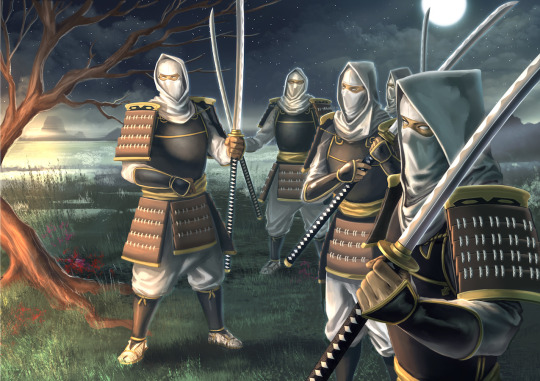
So, how do we turn this into a fun, playable, interactive game? Well, to answer that, first we have to talk about vampires.
Kenneth Hite’s Night’s Black Agents is an incredible roleplaying game. Using the GUMSHOE system, the game focuses on Jason Bourne/John Wick-style badass superspies and underworld agents taking on international vampire conspiracies. But to me, the most genius thing to come out of the game is the concept of the Conspyramid.
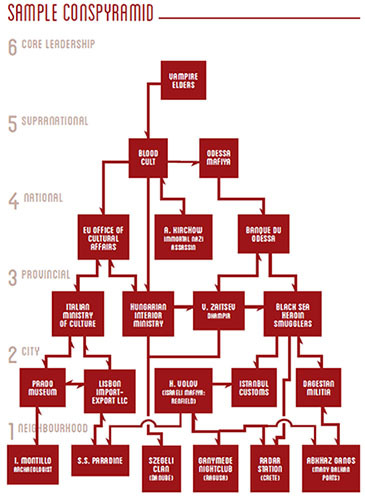
Simply put, the Conspyramid is a campaign organizational framework that allows you to outline a conspiracy (or cabal, or shadowy organization) in a way that makes it conducive to play. You set nodes in the Conspyramid, each one being a component of the greater conspiracy. These nodes could be bosses, protection, sources of funding, organizations, or safehouses that the conspiracy in question uses for their purposes. Each node lies on a different tier of the Conspyramid, with the higher tiers representing more and more powerful agents, bosses, or organizations in the conspiracy that has a higher influence over the others beneath them. Finally, we connect these nodes together with clues for the players to uncover, so that by taking on one node of the conspiracy, they can compromise it and unlock the connections to the other parts of the conspiracy.
So how does this help us for planning the Kolat? Well, if we turn the Conspyramid on its side, we have low-level nodes on the left, and higher-level nodes on the right. Now we have a campaign map. The players begin with a few nodes of knowledge on the left, and follow clues to the right, up the chain of command, and burying themselves in the intrigues of the conspiracy that they attempt to unravel. This way, unraveling each node of the Conspyramid is its own session, at the end of which the players gain clues that give them leads to other nodes of the conspiracy.
At the end of the day, as a GM you have constructed a narrative jungle gym on which the players can climb and explore the way they want to. As long as you guarantee that the players get the clues they need to continue (an excellent piece of design philosophy from the GUMSHOE system, worth stealing for any game), the players can tackle which threats seem the most pressing. This allows a good balance of being able to prepare structured plots and scenarios with the depth that L5R excels with, but also gives the players power to choose their own fates, leading to a pseudo-sandbox experience where player agency comes to the forefront.
So, using this Conspyramid tool, let’s look back at our original troubles in running a game about the Kolat conspiracy in L5R. Conspiracies are inscrutable and inaccessible by definition.
By using the Conspyramid, we have just outlined the way our conspiracy is structured. Nodes are connected to one another by clues that the players will stumble across, and this allows them to actually progress and explore the conspiracy in a meaningful way, rather than it being lost to the shadows of mystery and intrigue. Conspiracies are complicated.
Still true. But, at least using the Conspyramid, we have a way to outline and connect the dots of the most interesting parts of the Kolat, without having to worry about the exact wherabouts and responsibilities of every agent. As a GM, we don’t need to know the details about how Agent A is passing his information along through Couriers B, C, and D to get the information in the hands of Agent Z. All we need to know about is the big players in the conspiracy and how they interact with one another. Now all we need to know is that Agent A is providing money and resources to Agent B, and Agent B is being protected by a gang of thugs from Organization C. Much more palatable!
Even if you realize halfway through play that your conspiracy needs more or less nodes, it’s easy to improvise and change the structure of the Conspyramid once you draw it up. What if the conspiracy responds to the players’ actions by flipping a mercenary army to its own side? Easy! Figure out what tier of influence the conspiracy’s new army fits into, and add a few connections to the already-existing nodes so that the players can eventually uncover it and take them on.
Rokugan is a world where the social structure is set in stone.
Also still true, but we have to remember one major thing about the Kolat: They don’t play by the rules. The Kolat advocate for equality and the downfall of the Kami and the Imperial line. They are enemies of any upstanding Rokugani, and Rokugan’s strict social structure becomes a double-edged sword to them. True, they do not have to organize themselves in a way that is beholden to any accepted feudal structure of lords and servants, but the players also have considerable power as samurai. With the right allies, positions, and privileges, the players can make moves to beat Rokugan’s “Game of Daimyos” at their own game, leading to some awesome court and social scenes, something L5R is very happy to do.

So, for any of you L5R GMs who plan on running a Kolat game, I can’t stress enough how useful reading through Night’s Black Agents was for me. Adapting the Conspyramid structure and changing a few words around (changing ‘Nations’ to ‘Clans’), you can drag and drop elements into your game to make a centuries-old philosophical conspiracy easily manageable, and create an engaging narrative playground for your players to explore.
24 notes
·
View notes
Text
Shadow of the Cabal - Now in blog form
Hey, thanks for checking out the official blog of the Shadow of the Cabal podcast! The purpose of this blog is to serve as sort of a “Director’s Commentary” for the episodes we put out, and my thought processes for GMing games, especially L5R. If you want to listen to the show, you can visit the direct site, subscribe to the RSS feed, or find us on iTunes or Google Play. If you want to get in touch with me, I am also @sotcpod on Twitter. Feel free to send any questions or feedback on Twitter or here!

4 notes
·
View notes